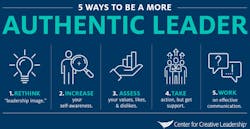Some describe leadership as having three foundational elements: competence, commitment to the leadership role and character. Character is the least-researched and least-represented element in leadership development programs, which is unfortunate because character is linked to good judgement.
A presentation at the National Fire Academy Executive Fire Officer (EFO) and Leadership Symposium in April 2023 was “Character-Based Leadership and How It Influences How We Lead.” The presenters were Kimberley Milani of the Ian O. Ihnatowycz Institute for Leadership at the Ivey Business School and Firefighter James Rychard of the Burlington Fire Department (Ontario, Canada).
One aim of the Institute is to “develop global citizens who have strength of character, strive to make a difference, and contribute to the flourishing of teams, organizations, communities and societies.”
One presentation slide was a diagram of a tree that has the three foundational elements of leadership. Competencies represented the full and thriving tree branches, commitment represented the strong tree trunk and character was the root system. Milani indicated that the root system was the foundational strength that’s needed for the tree to remain sturdy and to flourish for many years.
Milani said that the Ivey leader character framework includes 11 dimensions of character, each consisting of supporting observable behaviors. She emphasized the importance of developing character as a critical leadership practice to ensure efficacy and excellence in judgement and decision-making. She also shared that character isn’t something with which we are born, that it’s an aspect of ourselves that strengthens (or atrophies) over time. In fact, developing character is synonymous with exercising—the more that we lift weights, the more likely that we build muscles; as such, the more that we exercise character (i.e., engage in character-infused behaviors), the stronger that our character becomes. These efforts must be intentional, addressed when we don’t meet the mark and improved continuously.
The tactical takeaways from this presentation highlighted the criticality of character in the workplace. This ultimately drives personnel behavior and defines organizational culture. When personnel and organizations include the leader character framework, conversations are influenced, interactions and judgements are enhanced, and excellence is achievable.
Character and leadership
A search through EFO applied research papers produced results that discuss character and leadership. E. Scott Wolverton’s “Identifying Leadership Values and Traits for Battalion Chiefs of the Shreveport Fire Department” involved 188 responses to a questionnaire that was sent to the National Society of Executive Fire Officers (NSEFO). A few responses to a question that pertained to the importance of character and leadership effectiveness were:
• The ability to lead by example, have a good attitude, be humble and honest.
• It establishes a standard for others to follow.
• It is being consistent, patient and knowing individual needs.
• Being able to admit when you are wrong, standing up for the people you lead, and being willing to do the same things you are instructing.
As well, the NSEFO and the Congressional Fire Services Institute’s “Firefighter Code of Ethics” shares insight into how character influences decision-making.
Sculpting continuous improvement
As shared in “True Leadership: Twelve Principles Public Safety Leaders Must Adopt to Be Successful in the 21st Century” by P. Lamont Ewell (AuthorHouse, 2020), “The etymological root of the word ‘character’ comes from the Greek work ‘kharakter,’ which means an instrument that engraves, an instrument that chisels away to a distinctive quality. ‘Kharax’ is a pointed stake, meant to chip away. Picture a sculptor who is with a raw material. The artist must chip away at, chisel the stone, to begin to shape it into the image that’s envisioned. As the artist chips away, he or she carefully preserves and protects those areas that are important to retain in creating its desired image. This is precisely how our character is developed.”
Henry David Thoreau said, “You cannot dream yourself into a character, you must hammer and forge yourself into one.” This reminds me of Milani speaking on how much effort it takes to show up and be fully present. Although it’s unrealistic to expect to show up with our A-game 24/7/365, she shared how humility, self-awareness and intentionality aid continuous improvement. On days when we realize that we need more chiseling, we can own where we slipped, give it a name and move forward. For example, under stress, our patience might wane; that’s when we are able to recognize that our temperance is challenged and needs additional work.
Widespread commitment
The mission of the U.S. Air Force Academy (USAFA) Center for Character and Leadership Development (CCLD) is “To serve USAFA by advancing character and leadership development in preparation for service to the nation.” The USAFA hosts an annual National Character & Leadership Symposium, and the CCLD offers the free “Journal of Character & Leadership Development.”
In the employees section of its website, Yale University shared “Character in the Workplace Has Powerfully Positive Ripple Effects.” The page cites “The Advantage: Why Organizational Health Trumps Everything Else in Business” (Jossey-Bass, 2012). Author Patrick Lencioni wrote that all organizations experience distrust, secrecy, negativity and fear. The difference between a healthy and an unhealthy organization is the frequency and extent of such problems. If an organization is unhealthy, these dysfunctions tend to become widespread; worsening of the “illness” shows up in key indicators, including satisfaction, loyalty and productivity.
“Whether we realize it or not, our individual, daily acts of respect, integrity and character have powerful ripple effects,” Lencioni wrote.
Center for Creative Leadership (CCL) speaks to the need for authentic leadership. Building character and culture requires beliefs and behaviors to align with the organization. Some skills listed by the CCL are:
Self-awareness—Of yourself and relationship to personnel and the organization.
Genuineness, modesty and humility—Share the praise with your team.
Empathy and ethics—Make necessary decisions with integrity and support the team with commitment to doing what’s right.
Results-focus—Create a future beyond your present reality, energize personnel to clearly see the vision.
In “Principles: Life and Work” (Avid Reader/Simon & Schuster, 2017), Ray Dalio shared that we value people most who have character, common sense and creativity. “If your people are bound by a sense of community and mission and they are capable, you will have an extraordinary organization.”
Leadership development
Character is a critical component of our leadership and an instrumental factor to effective performance in the workplace. Many resources are available that might enhance awareness as well as provide insight on how to continue to intentionally chisel and forge into who you want to be.
Furthermore, your authenticity can promote continuous improvement, and you can leverage your personal attributes toward improved personnel experiences and organizational outcomes.
About the Author

Lindsay Judah
Lindsay Judah, DPA, CFO, CTO, currently serves as a consultant. Previously, she was a district chief in Florida. Judah is an alumna of and adjunct professor at Valdosta State University, where she teaches courses in organizational leadership and public administration. Her doctoral research focused on implementing innovation in the fire service, particularly UAV programs. Judah is an Everyone Goes Home Advocate, serves on the Awards and Scholarship Committee for the Florida City and County Management Association and participated on the International Fire Service Training Association’s Validation Committee for the fifth edition of “Chief Officer.”
